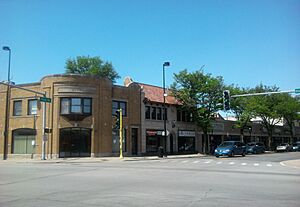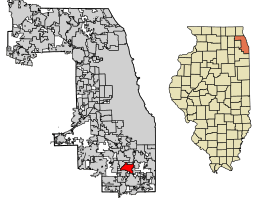Homewood, Illinois facts for kids
Quick facts for kids
Homewood, Illinois
|
||
|---|---|---|

Downtown Homewood
|
||
|
||

Location of Homewood in Cook County, Illinois.
|
||
| Country | United States | |
| State | Illinois | |
| County | Cook | |
| Townships | Bremen, Rich, Thornton, Bloom | |
| Founded | 1893 | |
| Government | ||
| • Type | village | |
| Area | ||
| • Total | 5.26 sq mi (13.63 km2) | |
| • Land | 5.22 sq mi (13.51 km2) | |
| • Water | 0.05 sq mi (0.12 km2) | |
| Elevation | 659 ft (201 m) | |
| Population
(2020)
|
||
| • Total | 19,463 | |
| • Density | 3,731.40/sq mi (1,440.74/km2) | |
| Time zone | UTC-6 (CST) | |
| • Summer (DST) | UTC-5 (CDT) | |
| ZIP Code(s) |
60422, 60430
|
|
| Area code(s) | 708 | |
| FIPS code | 17-35879 | |
Homewood is a friendly village located in Cook County, Illinois, in the United States. In 2020, about 19,463 people lived here. Homewood is just a short drive south of the big city of Chicago. It shares its borders with several other towns, like Flossmoor to the south and Harvey to the north.
Contents
Village Geography
Homewood covers about 5.26 square miles (13.63 square kilometers). Most of this area is land, with a small part being water. The village is located about 22 miles south of downtown Chicago.
Homewood is built on an old shoreline called the Calumet Shoreline. You can still see this ancient sandy ridge along Ridge Road today!
Local Economy
Homewood has a lively downtown area where Dixie Highway and Ridge Road meet. Here, you'll find many small businesses. These include cozy coffee shops, tasty restaurants, hair salons, a music store, and a bookstore. There's also a boutique hotel and the Homewood Science Center.
Another important business area is along Halsted Street. This street is home to many larger national stores.
Major Employers
Some big companies have offices in Homewood:
- The American headquarters for Canadian National Railways is here. Their campus has hosted over 15,000 employees and includes a training center.
- Tempo Global Resources, which used to be Hunter Douglas Metals, has its main global office in Homewood.
- Carl Buddig & Company, a food company, has its corporate offices here.
- Homewood Disposal, a company that handles waste for homes and businesses, has its headquarters in the village.
Parks and Green Spaces
Homewood is proud of its "H-F Park District," which manages over 365 acres of land. This includes 32 different parks and recreation spots.
Fun Parks in Homewood
Homewood has many unique parks and facilities for everyone to enjoy:
- Lion's Club Park and Pool, a great spot for swimming and playing.
- H-F Ice Arena, where you can go ice skating.
- Irons Oaks Environmental Learning Center, a place to learn about nature.
- H-F Racquet Club, for tennis and other racquet sports.
- Rover's Run Dog Park, a special place for dogs to play.
- Extreme Scene Skate Park, for skateboarding and scootering.
- Millennium Park Splash Pad, perfect for cooling off on hot days.
- Patriots Park Frisbee Golf Course, where you can play disc golf.
- Dolphin Lake Park and Clubhouse, a beautiful lakeside area.
Izaak Walton Preserve
The Izaak Walton Preserve is a large 193-acre natural area in Homewood. It's filled with woodlands, lakes, and lots of different wildlife. This preserve was formed from an ancient glacial lake and sandy shoreline.
You can walk or bike on about 4 miles of gravel paths that wind through the beautiful prairie. Many people enjoy fishing, biking, running, and walking their dogs here.
Media and Local News
Homewood has its own ways for people to stay informed and entertained.
Local Newspapers
- The HF Chronicle is a local newspaper that started in June 2014. It shares news and stories from both Homewood and Flossmoor communities.
Radio Station
- WHFH (88.5 FM), also known as Viking Radio, is the radio station of Homewood-Flossmoor High School. It's one of the most powerful high school radio stations, broadcasting with 1,500 watts!
Education in Homewood
Homewood offers great schools for its young residents.
Elementary and Junior High Schools
Most children in grades K-8 attend schools in Homewood Public School District 153. However, some students might attend Flossmoor School District 161 if they live in a specific area.
District 153 has three schools:
- Willow Elementary for grades K-2.
- Winston Churchill Elementary for grades 3-5.
- James Hart Junior High School for grades 6-8.
You can learn more at Homewood School District 153.
Homewood-Flossmoor High School
After junior high, most students go to Homewood-Flossmoor High School. This high school is its own school district (District 233). H-F High School has won the U.S. Department of Education's Blue Ribbon Award for excellence three times!
St. Joseph School
The Roman Catholic Archdiocese of Chicago used to run St. Joseph School. It closed in 2017. Even though the school is closed, the St. Joseph's Athletic Association still offers sports programs for elementary and middle school students. These sports include Girls Volleyball, Boys Basketball, and Girls Cheer.
Population and Community
| Historical population | |||
|---|---|---|---|
| Census | Pop. | %± | |
| 1900 | 352 | — | |
| 1910 | 713 | 102.6% | |
| 1920 | 1,389 | 94.8% | |
| 1930 | 3,227 | 132.3% | |
| 1940 | 4,078 | 26.4% | |
| 1950 | 5,887 | 44.4% | |
| 1960 | 13,371 | 127.1% | |
| 1970 | 18,871 | 41.1% | |
| 1980 | 19,724 | 4.5% | |
| 1990 | 19,278 | −2.3% | |
| 2000 | 19,543 | 1.4% | |
| 2010 | 19,323 | −1.1% | |
| 2020 | 19,463 | 0.7% | |
| U.S. Decennial Census 2010 2020 |
|||
In 2020, Homewood had a population of 19,463 people. There were about 6,964 households, with many families living in the village.
The community is diverse, with people from many different backgrounds. About 44.87% of the population was African American, and 43.17% was White. People of Hispanic or Latino background made up about 8.35% of the population.
The average age in Homewood was about 39.3 years old. About 26.1% of the population was under 18 years old.
Transportation
Homewood is a hub for transportation, making it easy to travel to and from the village.
Train Services
- Amtrak provides train service to Homewood. You can catch the City of New Orleans train to places like Kankakee, Tennessee, Mississippi, and all the way to New Orleans. The northbound train goes to Chicago Union Station.
- Homewood is also served by Amtrak's Saluki and Illini trains, which travel between Chicago and Carbondale, Illinois.
- Metra offers commuter rail service on the Metra Electric line. This train connects Homewood to Millennium Station in Chicago and University Park.
- Homewood is the American headquarters for Canadian National Railways. They have a large freight yard and major repair facilities here.
Bus Services
- Pace provides bus services with several routes. These buses connect Homewood to many different places across the Southland area.
Notable People from Homewood
Many interesting people have lived in Homewood, including:
- Sarah Bloom Raskin, who was the 13th United States Deputy Secretary of the Treasury.
- J Harlen Bretz, a geologist famous for his work on the Missoula Floods.
- Brian Colin, a video game designer known for games like Rampage and Arch Rivals.
- John Doody, who served as Mayor of Homewood and later as a member of the Illinois House of Representatives.
- Peter Doran, a geologist who studies climate and ecosystems in Antarctica.
- Manny Hoffman, another former Mayor of Homewood who also served in the Illinois House of Representatives.
- George Nolfi, a scriptwriter and producer for movies like Ocean's Twelve and The Bourne Ultimatum.
- Susan D. Page, the first United States Ambassador to South Sudan.
- Eugene Parker, an astrophysicist who developed the theory of the supersonic solar wind.
- Quintin E. Primo III, a co-founder of Capri Capital Partners, LLC.
- Steve Sarowitz, who founded Paylocity Corporation.
- Jermaine Stewart, an American R&B singer known for his hit song "We Don't Have to Take Our Clothes Off."
- Juice Wrld, a famous rapper, singer, and songwriter who grew up in Homewood.
See also
 In Spanish: Homewood (Illinois) para niños
In Spanish: Homewood (Illinois) para niños





